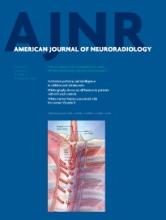Index by author
June 01, 2014; Volume 35,Issue 6
Huh, P.-W.
- FELLOWS' JOURNAL CLUBBrainOpen AccessClinical and Angiographic Features and Stroke Types in Adult Moyamoya DiseaseD.-K. Jang, K.-S. Lee, H.K. Rha, P.-W. Huh, J.-H. Yang, I.S. Park, J.-G. Ahn, J.H. Sung and Y.-M. HanAmerican Journal of Neuroradiology June 2014, 35 (6) 1124-1131; DOI: https://doi.org/10.3174/ajnr.A3819
DSA was used to study patients with Moyamoya disease with acute stroke. Advanced Suzuki angiographic stages, aneurysms, arterial occlusions, and collateral flow including transdural anastomoses were present more often in patients with hemorrhage than in those with only ischemia. These findings are the main contributors to the development of hemorrhagic strokes in patients with Moyamoya disease.
Hung, S.-C.
- BrainYou have accessStenotic Transverse Sinus Predisposes to Poststenting Hyperperfusion Syndrome as Evidenced by Quantitative Analysis of Peritherapeutic Cerebral Circulation TimeC.-J. Lin, F.-C. Chang, F.-Y. Tsai, W.-Y. Guo, S.-C. Hung, D.Y.-T. Chen, C.-H. Lin and C.-Y. ChangAmerican Journal of Neuroradiology June 2014, 35 (6) 1132-1136; DOI: https://doi.org/10.3174/ajnr.A3838
Hung, S.C.
- Patient SafetyYou have accessRadiation Doses of Cerebral Blood Volume Measurements Using C-Arm CT: A Phantom StudyW.F. Chu, C.J. Lin, W.S. Chen, S.C. Hung, C.F. Chiu, T.H. Wu and W.Y. GuoAmerican Journal of Neuroradiology June 2014, 35 (6) 1073-1077; DOI: https://doi.org/10.3174/ajnr.A3822
Hutten, R.
- EDITOR'S CHOICEBrainYou have accessAssociation of White Matter Hyperintensities with Low Serum 25-Hydroxyvitamin D LevelsJ.M. Prager, C. Thomas, W.J. Ankenbrandt, J.R. Meyer, Y. Gao, A. Ragin, S. Sidharthan, R. Hutten and Y.G. WuAmerican Journal of Neuroradiology June 2014, 35 (6) 1145-1149; DOI: https://doi.org/10.3174/ajnr.A3840
The relationship between white matter hyperintensities and serum vitamin D levels was assessed in adults. The authors found a significant relationship between vitamin D and white matter T2 hyperintensities in independent adult outpatients, especially those over 50 years of age, but no relationship between vitamin D levels and brain atrophy.
In this issue
American Journal of Neuroradiology
Vol. 35, Issue 6
1 Jun 2014
Advertisement
Advertisement








